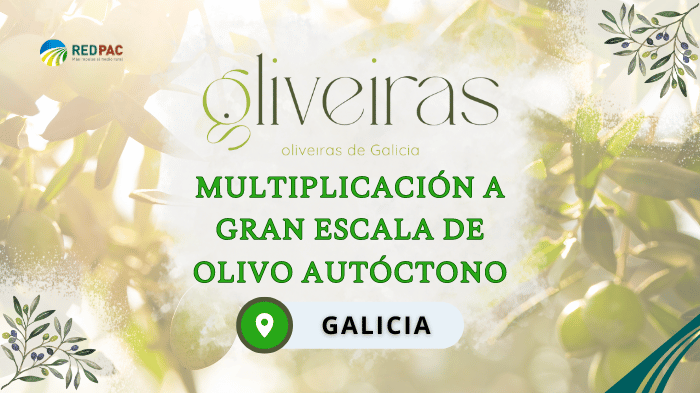
12 de July de 2024
Dinamización rural
Innovación
The Operational Group was established at the end of 2023 to study Galician olive varieties and test two propagation techniques: traditional cuttings and in vitro micropropagation.
- The project tests two different techniques to create more copies with less effort.
- The new demand will allow for increased production and the recovery of Galician varieties and farms.
Although there are many theories about a past with many more native olive trees in Galicia, it is known that at some point they disappeared, and it is not a crop that characterizes the area today.
However, many agricultural and scientific professionals are trying to recover them, and this requires finding optimal propagation methods.
The Oliveiras de Galicia Operational Group (GO) : Large-scale multiplication of native olive trees (classical cuttings and in vitro micropropagation) was created at the end of 2023 to study Galician olive varieties and improve two large-scale multiplication techniques:
- Classic cuttings: This is a crop propagation method that creates new specimens from selected fragments of so-called "mother plants." Cuttings are selected and treated, then planted.
- In vitro micropropagation: Genetically identical clones are generated from a fragment of the mother plant, thus creating uniform offspring in controlled environments outside of living organisms.
Project and objectives
The GO is specializing these techniques in 11 olive varieties from Galicia to meet the growing demand for olive trees among younger farmers. To this end, it is conducting comparative studies to observe the agronomic performance of these native varieties in the plantations of the Galician Biological Mission (CSIC) in Pontevedra and in the experimental plantation located at the Galician Agency for Food Quality ( AGACAL ) in A Pobra do Brollón (Lugo).
The objectives set are the following:
- Reducing the time required to obtain large numbers of specimens : in vitro micropropagation should allow for obtaining large quantities in less time.
- Promote plant rooting : thanks to two new types of hormones used with the cutting technique.
- Comparison of results : through the varied results of the two farms available to the project.
- Achieving differentiated quality : The goal is to create high-quality products with distinct characteristics. This would be achieved by cultivating cultivars that are already adapted to the climate and soil of the autonomous community.
- Conservation of agricultural biodiversity , an objective achieved through the very activity of optimizing olive varieties that were no longer widely used.
Ultimately, it's about improving quality, testing two feasible techniques, growing more olives from the area, and supplying plant nurseries to meet demand.
Expected results
The Galician Olive Tree Association (GO Oliveiras de Galicia) isn't starting from scratch. This project has involved over 10 years of research by the CSIC to identify Galician olive varieties. The Juana de Vega Foundation, which coordinates the project, has worked with the center to identify and describe 20 native varieties , of which 11 have been commercially registered and 2 (Brava Gallega and Mansa Gallega) have been approved as conservation varieties.
Thus, with clear initial objectives, the GO aims to achieve the following results by the end of 2026:
- Optimize the multiplication of native Galician olive trees through conventional cuttings and in vitro micropropagation to meet the growing demand for plants.
- Evaluate the field adaptation of plants produced by both multiplication methodologies.
- To harness and register native Galician olive varieties as unique and potentially valuable agricultural resources for the agri-food sector.
- Recover abandoned farms in Galicia, taking advantage of their suitability for olive cultivation.
- Use olive cultivation to conserve biodiversity and as a productive tool.
- Revitalize Galicia's olive groves, producing quality oils and restoring their historical importance in the region.
Furthermore, the results are intended to be transferred to olive growers and nursery growers so they can collaborate in the recovery of traditional varieties and share knowledge throughout the value chain.
Partners and financing
The Oliveiras de Galicia Operational Group is a consortium led by the Juana de Vega Foundation and made up of the Biological Mission of Galicia (CSIC) , the Galician Food Quality Agency ( AGACAL ) of the Department of Rural Affairs, Ouro de Quiroga and Olivar de la Concordia , with the external collaboration of the Cultigar laboratory .
The project has a budget of 179,652.68 euros, fully financed by the European Union through the European Agricultural Fund for Rural Development ( EAFRD ) within the framework of the CAP Strategic Plan ( PEPAC ) 2023-2027.









